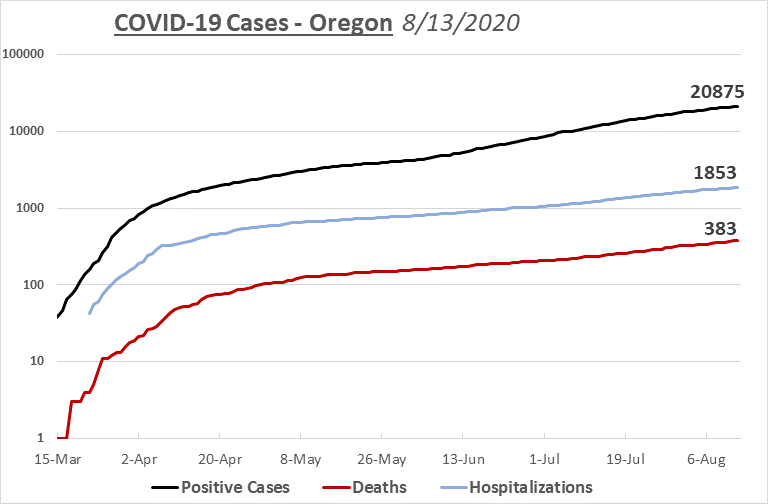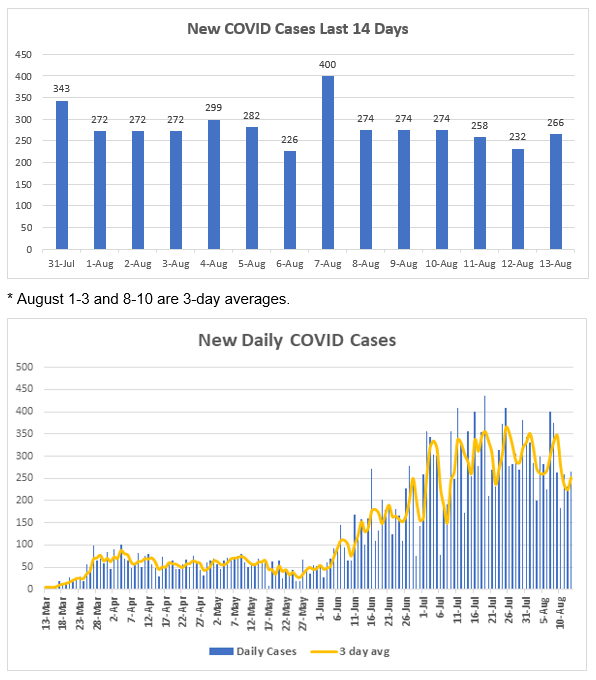|
August 13, 2020
I hope that you and your loved ones are doing well, staying healthy, cheering on the Trail Blazers, and looking out for your neighbors and friends.

TODAY’S CORONAVIRUS AND CORONAVIRUS RESPONSE UPDATE
-
Positive Cases: OHA reports that 266 additional Oregonians have tested positive for COVID. The cumulative total for those testing positive is 21,141.
-
Total Tests: The number of tests has increased by 4,709. The cumulative number of tests since the pandemic began is now 466,104.
-
Ratio: The percentage of positive tests today is 5.6%. The national percentage today is 5.8%.
-
Deaths: I’m very sorry to report 8 additional deaths due to the coronavirus today. You can read more about those we lost further down in the newsletter. The total number of COVID deaths in Oregon is now 383.
-
Hospitalized: OHA reports that an additional 8 Oregonians have been hospitalized with COVID. The cumulative number of those who have been hospitalized with COVID since the beginning of the pandemic is 1,853.
-
Presumptive Cases: OHA is including “presumptive COVID-19 cases” in its daily reports, consistent with recently amended guidance from the Centers for Disease Control and Prevention. A presumptive case is someone who does not yet have a positive PCR test result but is showing symptoms and has had close contact with a confirmed case. If they later test positive by PCR, those will be recategorized as confirmed cases. OHA reports 28 new presumptive cases today and a cumulative total of 1,159 Oregonians presumed positive.
-
Other Hospital Information:
- Patients Currently w COVID-19 Symptoms (who may or may not have received a positive test result yet): 232 (19 more than yesterday). Of those, 156 have already received a positive test back.
- Available ICU Beds: 159 (same as more than yesterday)
- Other Available Beds: 626 (63 fewer than yesterday).
- ICU Patients w COVID-19 Symptoms: 57 (7 more than yesterday).
- COVID-19 Patients Currently on Ventilators: 22 (5 more than yesterday).
- Available Ventilators: 771 (8 more than yesterday).
-
Dashboards
-
Today’s National Numbers:
-
PPE: In the last 24 hours the Emergency Coordination Center has not received any additional Personal Protective Equipment. You can track the history of incoming and outgoing PPE shipments here.
-
Additional Brief Updates:
- The Governor announced today that she is ordering Malheur County back to Phase One Reopening. This comes as no surprise, given the high infection rates that we’ve been seeing there over the last month, in part the result of its proximity to Western Idaho, one of the nation’s current hot spots. The County Commission itself took steps last month to roll back some of the Phase Two standards. The White House recently characterized Ontario and Malheur County as being in the “Red Zone,” an area where stricter restrictions (including closing bars) are needed, and it called on the Governor to take action. For a local perspective, the Malheur Enterprise has a story about the decision and the responses.
- Each day I pass along the statewide numbers of available ICU and non-ICU hospital beds. OHA now has a regional hospital data dashboard that provides this information in real time. Hospitals are grouped together in seven regions. It also has a tab that shows this information over time.
Update on the Science of Reopening Schools
As health officials, school districts, parents, and legislators are wrestling with decisions over what school will look like this year, we’re all looking to science to help us understand what will keep our students and educators safe. One of the most respected sources of information out there is the National Academy of Sciences. The Academy has been organizing and sharing a series of covid-related webinars, the most recent of which is on the science of school reopening that was held yesterday.
It featured Dr. Wendy Armstrong of Emory University, Dr. Caitlin Rivers of the Johns Hopkins University, Donna Mazyck (Executive Director of the National Association of School Nurses), and Dorte Lange of the Danish Union of Teachers.
The above link will allow you to watch the webinar, access PowerPoints, and link to the transcript of the webinar. (However, when I last checked, the link was to another webinar; I emailed them to point it out and hopefully it will be corrected soon.)
Here are some of the insights that I found most interesting:
- Despite earlier thinking that children were not affected by the virus, we now know that that is not the case. The U.S. has had 380,000 cases in young children and teenagers, 180,000 in the last four weeks alone. As of August 6, 9.1% of all COVID cases have been children and teens. Children and teens comprise 22% of the U.S. population.
- Children are less likely than adults to have severe consequences: less than 3% of the cases have led to hospitalization, less than 1% to death.
- There is growing evidence that young children are much less susceptible to the disease than are older children. Age ten seems to be the point of demarcation.
-
A new epidemiological study from Geneva reported in The Lancet showed little difference in risk between children aged 10-18 and adults; however, younger children (age 5-9) were 1/3 as likely to be infected.
- Those findings confirm the evidence in an earlier study of 22,000 residents in Iceland, which showed that children under the age of 10 are half as likely to be infected than teens. (You can find this study in The New England Journal of Medicine.)
- Recently-released statistics from South Korea showing the results of contact tracing of 59,000 individuals reveals (a) that transmission from household members is 5-times higher than from non-household members; and (b) the group most likely to be infecting other household members are teens. Children under the age of 10 are far less likely to be what’s known as the “index patient,” i.e., the source of the disease.
-
A recent study in The Journal of the American Medical Association suggests that school closures in the spring may have played a significant role in temporarily containing the spread of the disease.
- There is increasingly clear evidence that children are infectious, especially when they are symptomatic.
- School reopening plans need to be tied to the state of community spread in the region.
- The CDC has not issued recommendations for in-person reopening metrics. Some academic medical associations have. Based on those recommendations, Oregon’s new reopening metrics seem to be in line with the preferred standards; Oregon’s new rural/remote standards are in line with those considered acceptable.
- Denmark had great success with its school reopening because it coincided with infection rates being on a steep decline. National case counts remain very low.
- They began with primary schools, and classes were kept very small.
- In combination with smaller class sizes, teachers in Denmark were given a lot of flexibility and discretion over targeting class content to individual students. They believe that children actually learned more as a result and made up what they had lost during closure.
- School nurses have a particularly important role to play in monitoring health during the pandemic, whether children are physically in school or at home. Unfortunately, most Western states (including Oregon) are seriously under-resourced with school nurses.
- Core questions remain around why younger children are less susceptible and less infectious. Many studies are still in process.
If this is a subject that interests you, please check out the webinar and the PowerPoints, and let me know your thoughts.
Where Are Today’s New Cases?
If we put together the positive test results and new “presumptive” cases reported today, the overall number of new cases is 294. More than half of today’s cases come from outside the Portland Tri-County region. Here is the breakdown by county for today:
Baker (3)
Benton (5)
Clackamas (14)
Columbia (1)
Crook (1)
Deschutes (4)
Hood River (2)
Jackson (16)
Jefferson (13)
Josephine (2)
Klamath (2)
Lane (7)
Lincoln (7)
Linn (4)
Malheur (12)
Marion (35)
Morrow (6)
Multnomah (84)
Polk (6)
Tillamook (1)
Umatilla (20)
Union (2)
Wasco (2)
Washington (36)
Yamhill (9)
And the Deaths
Oregon’s 376th COVID-19 death is an 83-year-old woman in Malheur County who tested positive on August 5 and died August 10 in her residence.
Oregon’s 377th COVID-19 death is a 75-year-old man in Multnomah County who tested positive on July 16 and died on August 8, at Kaiser Westside Medical Center.
Oregon’s 378th COVID-19 death is an 80-year-old woman in Clackamas County who tested positive on August 2 and died on August 9.
Oregon’s 379th COVID-19 death is an 81-year-old man in Clackamas County who tested positive on August 5 and died on August 11 at Providence St. Vincent Medical Center.
Oregon’s 380th COVID-19 death is an 85-year-old man in Deschutes County who tested positive on July 12 and died on August 9 in his residence.
Oregon’s 381st COVID-19 death is a 55-year-old man in Columbia County who tested positive on August 7 and died on August 9 at Kaiser Sunnyside Medical Center.
Oregon’s 382nd COVID-19 death is a 78-year-old woman in Multnomah County who tested positive on August 6 and died on August 7 at Providence Portland Medical Center.
Oregon’s 383rd COVID-19 death is an 84-year-old man in Multnomah County who tested positive on July 30 and died on August 9 at Providence Portland Medical Center.
Additional Graphs:




Want to See Past Newsletters?
If there was COVID-related information in a past newsletter that you want to go back to, but find you’ve deleted it, you can always go to my legislative website (www.senatordembrow.com), click on “News and Information,” and you’ll find them all there. Also, if someone forwarded you this newsletter and you’d like to get it directly, you can sign up for it there.
AND FINALLY,
Here again are some resources that you will find useful:
If the above links are not providing you with answers to your questions or directing you to the help that you need, please consider me and my office to be a resource. We’ll do our best to assist you or steer you in the right direction.
Best,
 Senator Michael Dembrow
District 23
email: Sen.MichaelDembrow@oregonlegislature.gov
web: www.senatordembrow.com
phone: 503-986-1723
mail: 900 Court St NE, S-407, Salem, OR, 97301
|